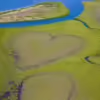New Caledonia Travel Guide
Welcome to the taste2travel New Caledonia Travel Guide!
Date Visited: August 2018
Introduction
The very French territory of New Caledonia offers a blend of Parisian chic, style and sophisticated ambience, mixed with laid-back Melanesian charm.
Due to its large French expat community, New Caledonia, and especially Nouméa, has a distinctly continental feel, especially in the ritzy beach side neighbourhoods of Baie des Citrons and Anse Vata, which feel more French Riviera than Pacific seaside.

The ‘Heart of Voh’ is a naturally occurring heart-shaped bog inside a mangrove swamp.
New Caledonia is uniquely classified as a “special collectivity of France” and while not a cheap destination, the territory offers many varied and rewarding travel experiences, both on the mainland and the smaller outer islands.
While many visitors choose to spend their time soaking up the agreeable atmosphere of the capital, there are a wealth of fascinating sights elsewhere which can easily be visited with a rental car.

La Grande Terre is an island of stark contrasts.
The main island and mainland, La Grande Terre, is a 400 km long, narrow slither of land which was formerly part of Australia (believed to have separated roughly 66 million years ago).
As a visiting Australian, I was often struck by the similarities in landscapes between New Caledonia and Australia. From the arid, red-earth expanses of Le Grand Sud (Great South region), which has a distinctly outback look and feel, to the green hills of the central agricultural belt, to the groves of paperbark and gum trees which line the highways – New Caledonia looks and feels like Australia!

The stunningly beautiful Kuto Bay, a highlight of the Isle of Pines.
South of the main island is the picturesque Isles of Pines, a popular tourist playground famed for its stunning white-sand beaches and towering Araucaria pine trees.
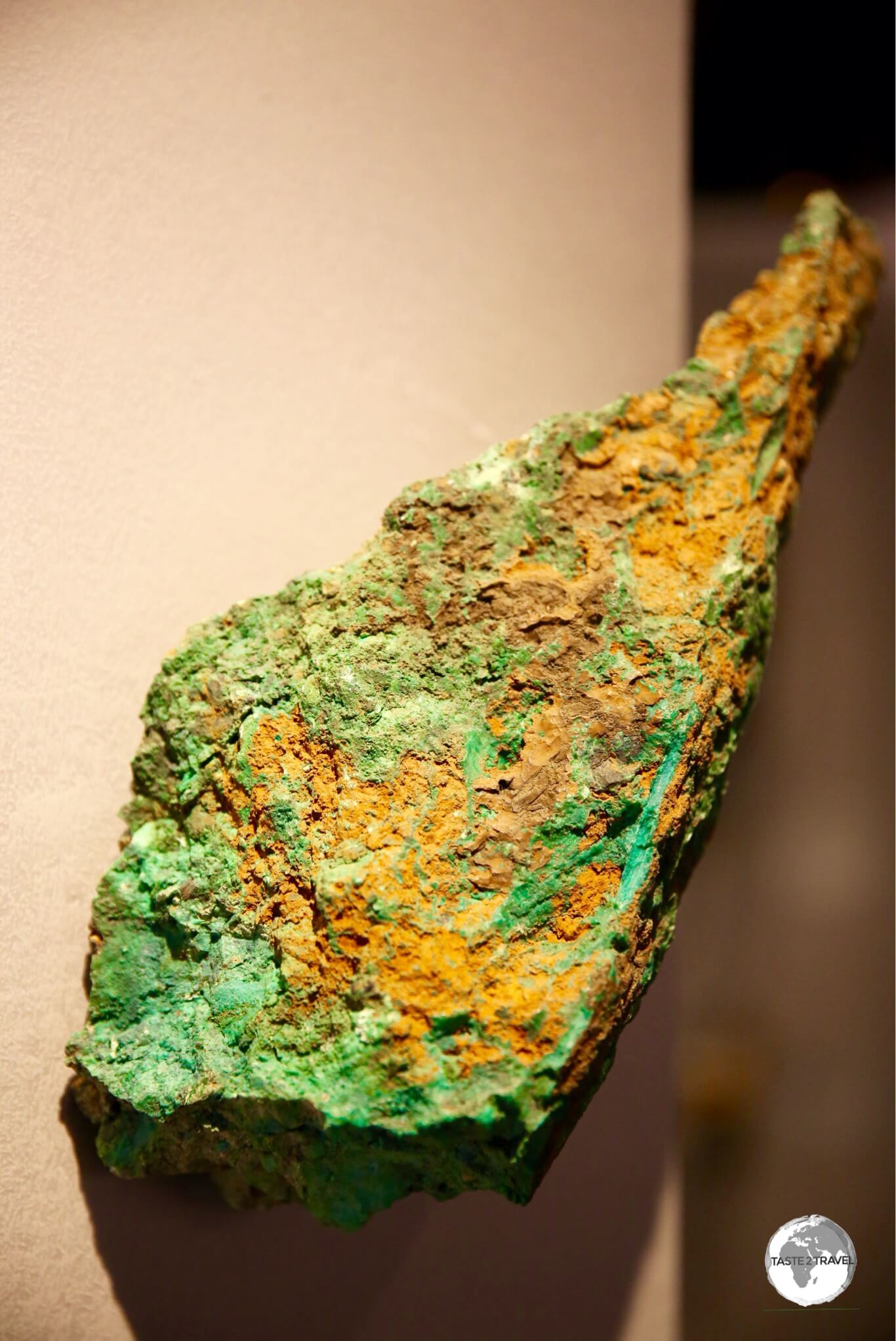
Nickel on display at the Maritime museum in Noumea.
New Caledonia is home to 10 percent of the world’s nickel deposits. As a result, nickel processing is the most important sector of the economy, and is the main source of revenue for New Caledonia.

Historic St. Louis church is located on a hill, on the outskirts of Noumea.
This, combined with annual fiscal transfers of more than one billion US dollars from the French government, have meant that the territory has never had to rely on tourism. However times are changing and tourism is now becoming more important to the economy, and the government – through New Caledonia Tourism – is actively promoting this magical corner of the South Pacific.

A hand-painted sarong showing traditional Kanak motifs.
I thoroughly enjoyed my time in New Caledonia and cannot wait to return to explore the Loyalty Islands and enjoy more fine French pastries at my favourite Nouméa pâtisseries.
Location
Noumea, New Caledonia
New Caledonia is located in the South Pacific – 1,210 km (750 miles) east of Australia, 630 km (392 miles) south of Vanuatu, 4,715 km (2,930 miles) west of French Polynesia and 20,000 km (12,000 miles) from France.
The territory is an archipelago, which is comprised of the main island of La Grande Terre, the Loyalty Islands to east, the Belep archipelago to the north and the Isle of Pines to the south.
People

Artwork depicting the faces of New Caledonia at the Museum of New Caledonia.
The Kanak are the indigenous Melanesian inhabitants of New Caledonia and today comprise 40% of the population. Historians believe that, along with Australian Aborigines, the Melanesians emigrated from Africa into southern Asia between 50,000 and 100,000 years ago.

A map of the Melanesian region of the Pacific Ocean.
Source: Wikipedia
Using land bridges, which existed due to low sea levels, the Melanesians eventually migrated east to Australia and New Guinea, arriving there 40,000 years ago.
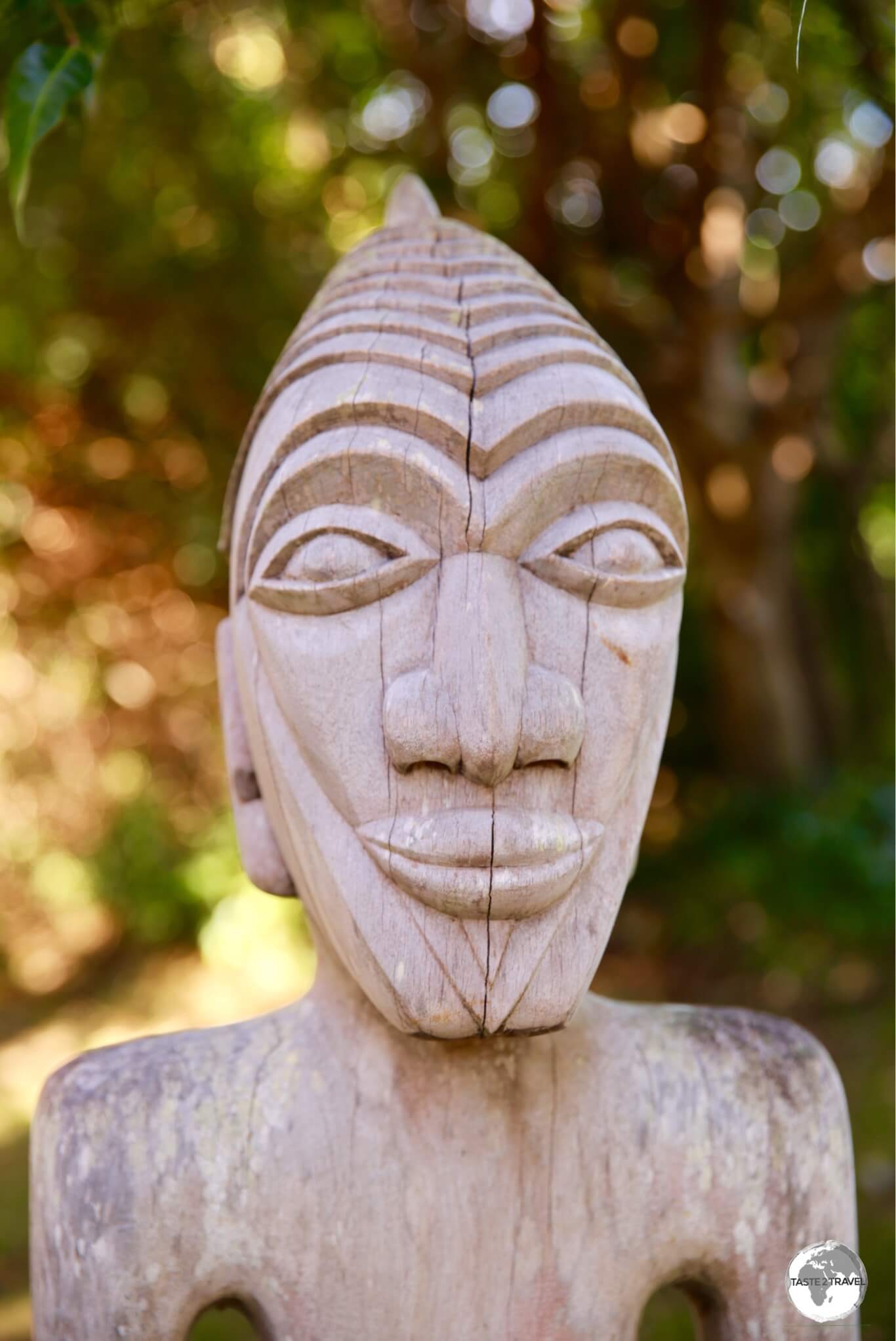
A traditional Kanak wood carving.
A further migration into the eastern islands of Melanesia (including New Caledonia) came much later, probably between 4000 B.C. and 3000 B.C.
DNA tests have shown that the Melanesians are distinctly different to Polynesians and Micronesians who it’s believed arrived in the Pacific from what is today Taiwan.
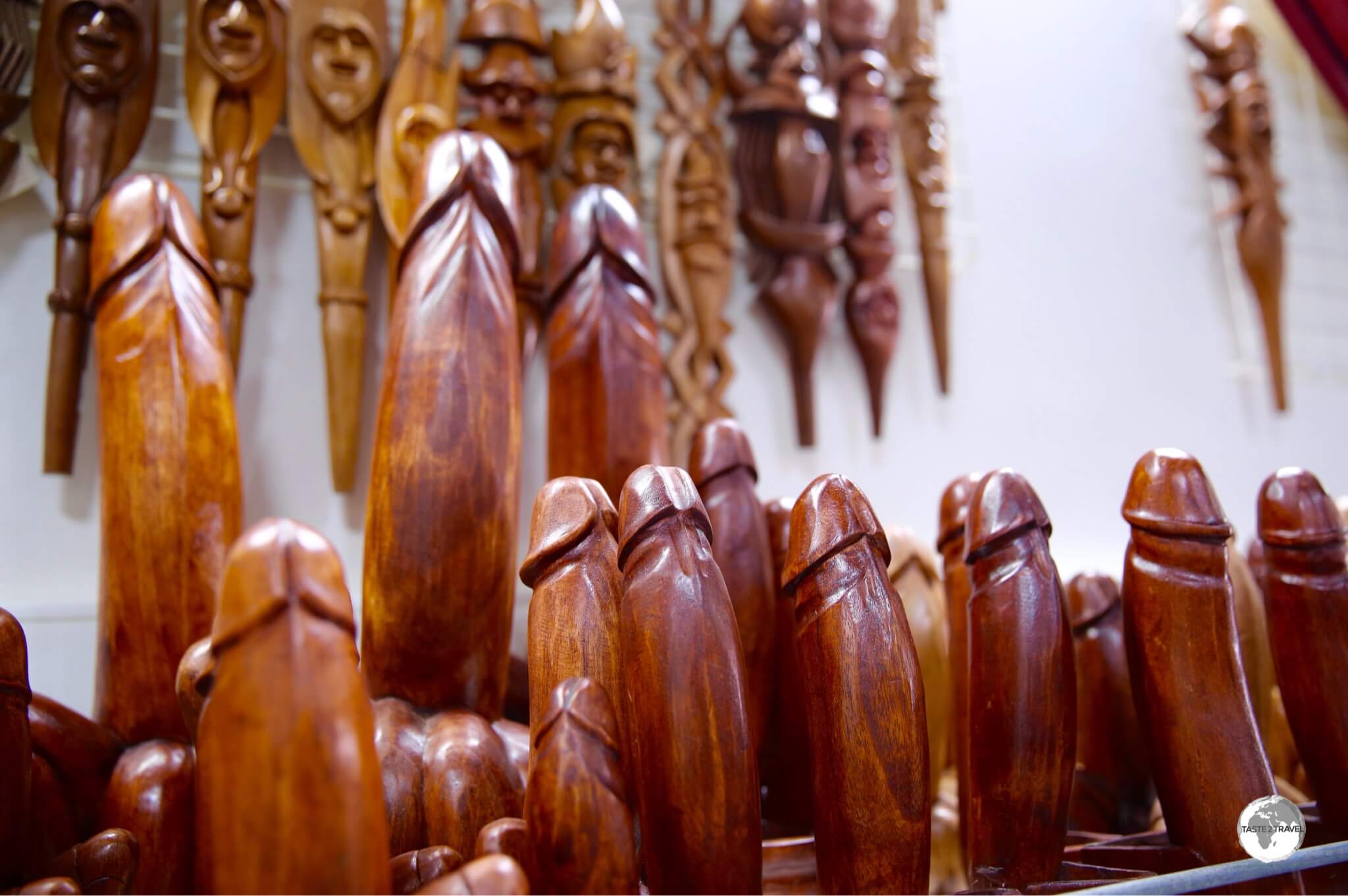
The phallus is of symbolic importance in the Kanak culture and today a popular souvenir item.
Since colonial times, immigrants have arrived from metropolitan France and various other francophone colonies. Of the current population of 278,000, two-thirds live in the greater Noumea area.
Flag

The flag of New Caledonia.
Until 2010, the French flag was the only flag flown in New Caledonia. However, in July of that year, the Congress of New Caledonia voted in favour of a motion to fly the Kanak flag alongside the French tricolor.

The Kanak flag has flown alongside the French flag since 2010.
The flag in use today features a blue horizontal band which symbolizes both the sky and the ocean surrounding New Caledonia. The red symbolises the blood shed by the Kanaks in their struggle for independence while the green symbolises the land.
At its centre, the yellow disc is a representation of the sun and the symbol upon it consists of a flèche faitière, a kind of arrow that adorns the roofs of Kanak houses.
Currency

The Pacific Franc is used in the French Pacific territories of New Caledonia, French Polynesia and Wallis and Fortuna.
The unit of currency in New Caledonia is the cours de franc Pacifique (CFP), which is referred to as the ‘Pacific franc’. Financial institutions abbreviate the currency “XPF“, but in this guide I use the locally used abbreviation – ‘CFP‘. The same currency is used in the other French Pacific territories of French Polynesia and Wallis and Futuna.
The franc is pegged to the euro at a rate of 1 Euro = 119.33 CFP ($1USD = 103.60 CFP).
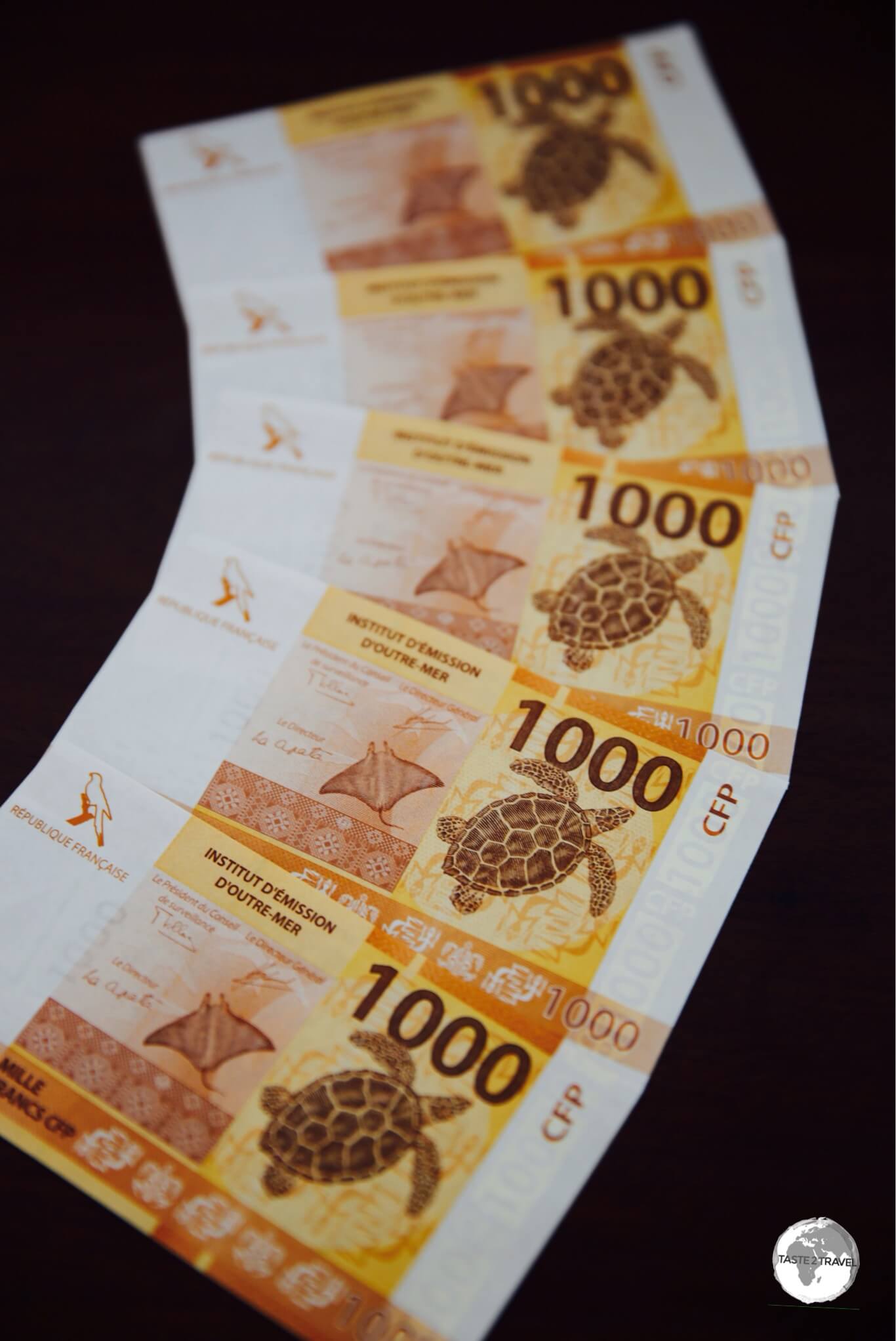
‘1000 Pacific Franc’ bank notes.
Costs
Not cheap!
I met few budget travelers in New Caledonia, although, if you don’t mind camping and hitchhiking you could keep costs down. To really enjoy New Caledonia you should have a well-endowed bank account!
Some sample costs:
- Coca Cola (0.33 litre): 350 CFP (US$3.35)
- Cappuccino/ Cafe Latte: 500 CFP (US$4.82)
- Domestic Beer (.5 litre): 725 CFP (US$7.00)
- Combo meal at McDonalds: 1,150 CFP (US$11.10)
- Entrée in a restaurant: 1,500-1,800 CFP (US$14.50 – $17.40)
- Main course in a restaurant: 2,800+ CFP (US$27.00 +)
- One-way shuttle bus from La Tontouta airport to downtown Noumea: 3,000 CFP (US$29.00)
- Dorm bed at a backpackers in Nouméa: 1,900 CFP (US$18.40)
- Room in the mid-range ‘Hotel Beaurivage’ in Nouméa: 8,000 CFP (US$77)
- Room in the top-end ‘Hilton Hotel’ in Nouméa’: 19,000 CFP (US$185)
The Great Telco Robbery
Philately

Postal services in New Caledonia are provided by Office des Postes et Télécommunications (OPT).
Postal services are provided in New Caledonia by the Office des Postes et Télécommunications (OPT), who produce colourful local stamps featuring the fauna, flora and culture of New Caledonia.
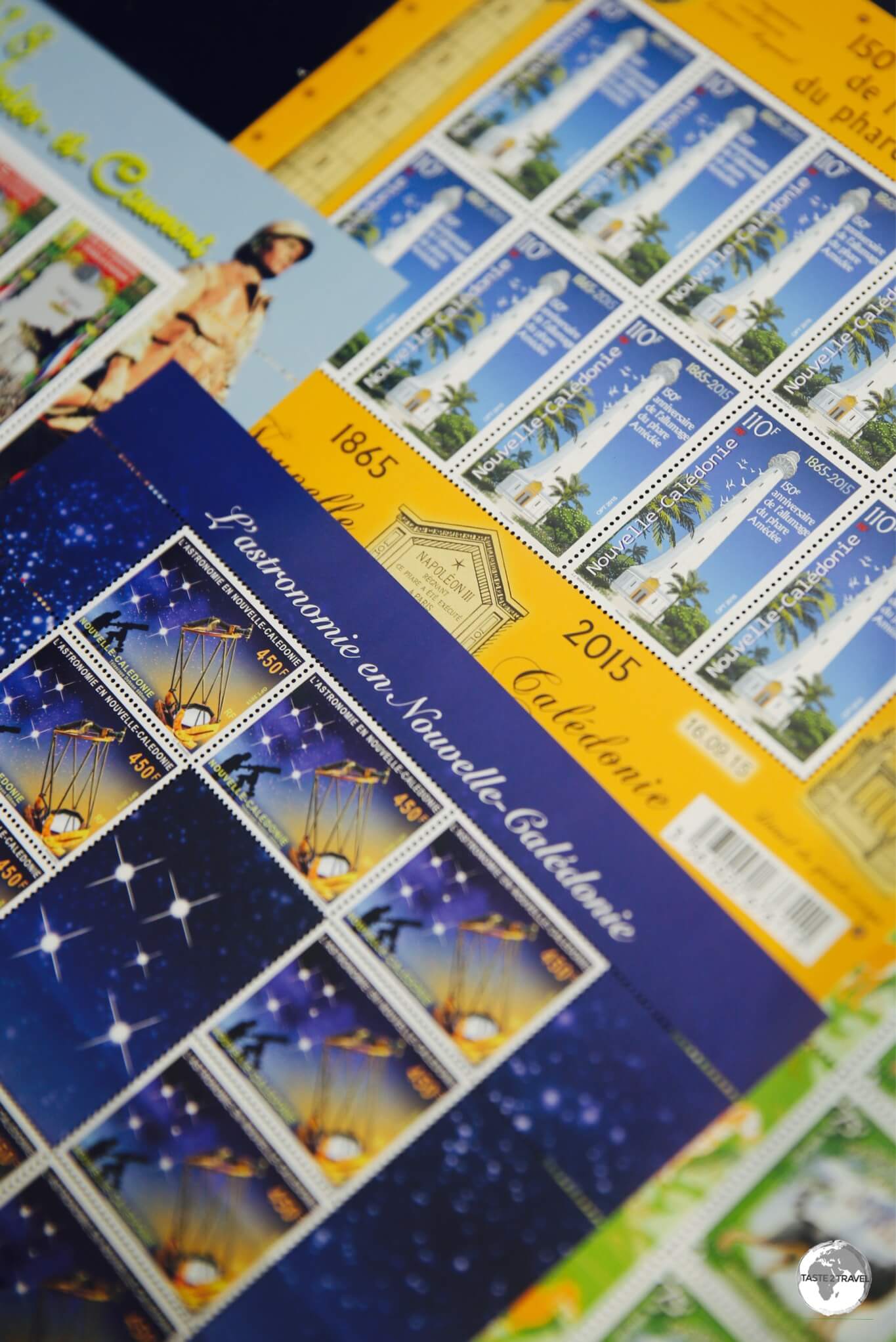
Stamps on sale at Calédoscope, the OPT philatelic shop in downtown Noumea.
Stamps are popular with philatelists around the world and can be purchased directly from Calédoscope, a dedicated philatelic shop in downtown Nouméa, or online from the OPT website.

Stamp artwork from New Caledonia often features the colourful fauna and flora found throughout the archipelago.
Sightseeing
La Grande Terre

The Lagoon which surrounds La Grande Terre is the longest continuous barrier reef in the world and is UNESCO World-Heritage listed.
Measuring 400 km in length, La Grande Terre is the mainland of New Caledonia. Surrounded by a UNESCO-World Heritage listed lagoon, the longest continuous barrier reef in the world and the second largest after the Great Barrier Reef of Australia, the lagoon offers diving, snorkeling, abundant marine-life, pristine reefs, whale watching, one spectacular blue hole and lots of beautiful beaches.

The reef which surrounds La Grande Terre is the second largest in the world, after the Great Barrier Reef of Australia.
The sparsely populated east coast is characterised by towering, rugged mountains which plunge into the sea, while the west coast offers gentle plains and green, rolling hills and is the agricultural heartland of the country.

Exploring the Le Grand Sud region in my rental car.
Directly east of Nouméa is the spectacularly beautiful Le Grand Sud (The Great South) region, which looks like a slice of outback Australia which has been transplanted into the South Pacific. The sites of Le Grand Sud can easily be covered on a day-trip from Nouméa.
Nouméa

Street art in downtown Noumea.
With a population of 97,500, Nouméa is the largest city and capital of New Caledonia. Home to a large French expat population and known for its French influences from ritzy boutiques, fine dining restaurants, pâtisseries, boulangeries and cafés, the city feels like an outpost of France in the South Pacific.
Jean-Marie Tjibaou Cultural Centre

A display at the Jean-Marie Tjibaou Cultural Centre in Nouméa.
Opened in 1998, the magnificent Jean-Marie Tjibaou Cultural Centre, was designed by Italian architect Renzo Piano who incorporated Kanak design elements into the construction of the buildings.
The centre houses a number of galleries and uses a variety of artistic mediums to celebrate the cultural heritage of the indigenous Kanak people. Highly recommended!
St. Joseph Cathedral

St. Joseph Cathedral in Noumea.
This Roman Catholic church dominates the city skyline from its hilltop position above town. Built between 1887 – 1897 in the neo-Gothic style, the two 25 metre tall towers do not have spires, which is an anticyclone design feature.

The interior of St. Joseph’s Cathedral in Noumea.
Museum of New Caledonia

A display of Kanak artefacts at the Musée de Nouvelle-Calédonie (Museum of New Caledonia) in Nouméa.
The Musée de Nouvelle-Calédonie, which was founded in 1893, houses an extensive display of regional ethnography & visual arts. The museum includes displays of indigenous cultures and artefacts from the wider Pacific region.
Maritime Museum of New Caledonia

A display at the Maritime Museum of New Caledonia in Nouméa.
The engaging Musée maritime de Nouvelle-Calédonie is located opposite the Noumea container terminal, in a building that was formerly a maritime station.
The museum exhibits trace local maritime history from the first indigenous settlers, who reached New Caledonia in traditional canoes, to the arrival of Europeans, to the Pacific War, and the American presence in the territory during the WWII.
World War II Museum

Displays at the World War II Museum in Noumea.
The Musée de la Seconde Guerre Mondiale is housed inside a modern replica of a corrugated iron Quonset hut (the prefabricated building of choice used by the US Military during the Pacific war).
New Caledonia was essential to the United States’ prosecution of the Pacific war and the displays outline how the local population turned their backs on the far-off French (Vichy) regime and threw their support behind the Americans.
As a result of the American presence on the island during the war, local Kanaks started to agitate for independence from France, a movement which is still ongoing today.
Museum of the City of Nouméa

Displays at the Museum of the City of Noumea.
Located downtown on Place des Cocotiers, the Musée de la Ville de Nouméa is housed inside a charming colonial mansion which was originally the head office of the first bank established in the territory. Today, the museum features exhibits on three floors, which trace the history of Nouméa.
Place des Cocotiers

The Kiosque à Musique at Place des Cocotiers in Noumea.
Located in the heart of the city, Place des Cocotiers is the main square of Noumea.
Situated at the northern end of the square, the Kiosque à Musique is a pretty wooden rotunda which was constructed in 1878 from funds raised by the Union of Transportation Workers and today serves as a popular place for locals to relax and is also the venue for occasional concerts.
Baie des Citrons
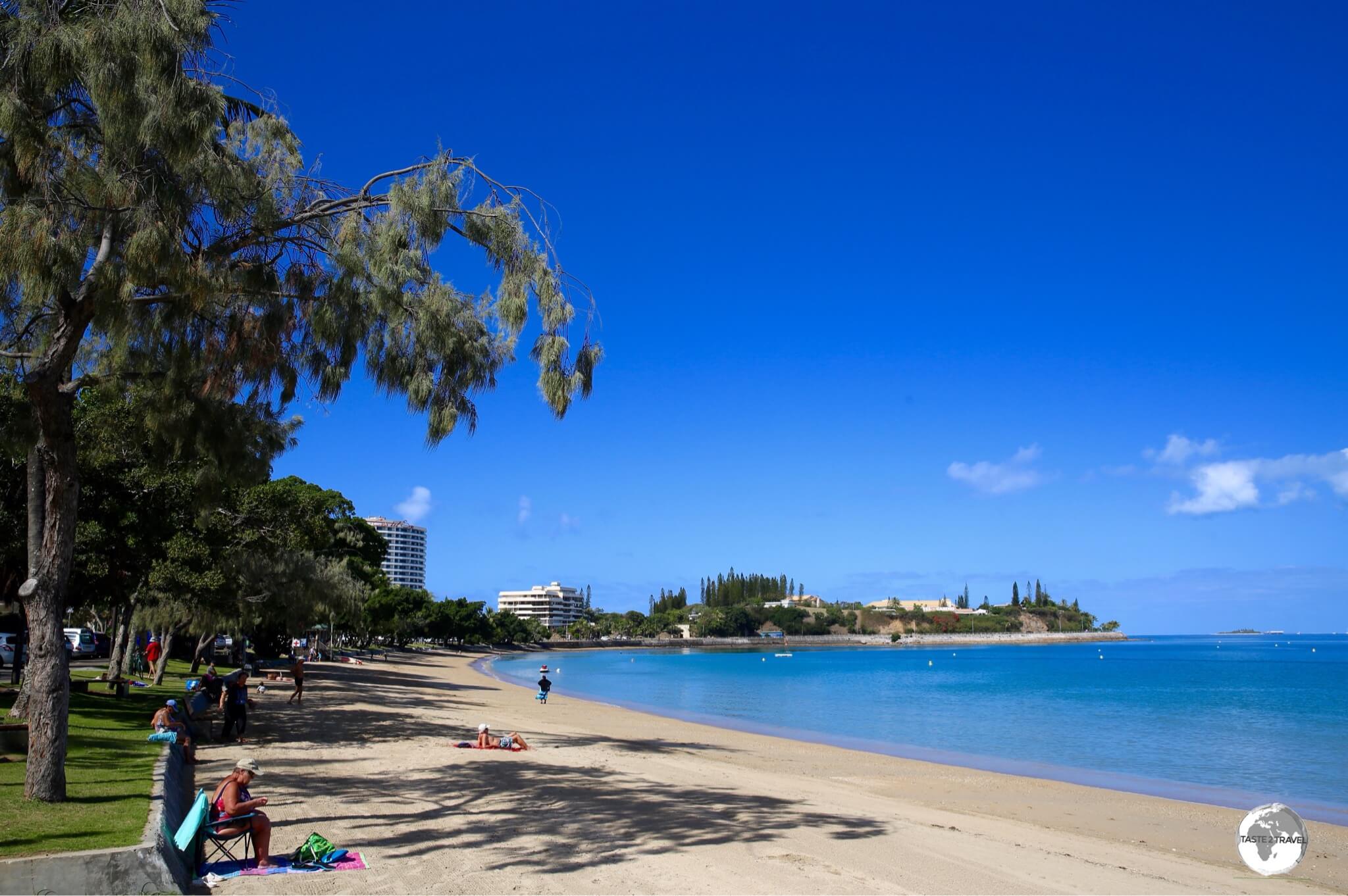
Baie des Citrons is one of the most popular beaches in Noumea.
A popular, busy beachside suburb, Baie des Citrons (Lemon Bay) is located a short drive south of downtown Noumea. This is one big playground which draws those looking to swim, exercise, picnic.
Lining the beach is the largest collection of restaurants, bars and hotels in Noumea, making Lemon bay the liveliest neighbourhood in the capital.

The sweeping Baie des Citrons is a popular recreation area in Noumea.
The best news, a highly recommended mid-range hotel is located in the heart of this neighbourhood (see the ‘Accommodation‘ section below for more details).
Anse Vata

Anse Vata beach is popular with locals and tourists and is home to many hotels, restaurants and cafes.
A short stroll from Baie des Citrons, Anse Vata is a popular tourist hub. Framed by a wide, sandy, swimming beach, Anse Vata is home to numerous restaurants, cafés ,ice-cream shops, bars, boutiques and everything else a tourist might need while on holiday.
Amédée Island

The 56-metre high Amédée Lighthouse soars above the island of the same name.
Located 24 kilometres offshore of Nouméa, this tiny slice of paradise is home to the Amédée Lighthouse, the tallest metal lighthouse in the world.

The spiral staircase which climbs 56 metres to the top of Amédée Lighthouse.
At 56 metres tall, le Phare Amédée (Amédée Lighthouse) is one of the tallest lighthouses in the world. It was constructed from iron panels in Paris in 1862, then dismantled and shipped in crates to New Caledonia where it was re-assembled on the island.

A panoramic view from the top of Amédée Lighthouse.
A spiral staircase winds its way to the top from where you have panoramic views of the island and beyond.

Amédée Island is a nesting site for the highly venomous “Tricots Rayé” (Striped Sea Snake).
Amédée Island is a favourite nesting site for the Tricots Rayé, the Banded sea snake. Although highly venomous, their mouths are tiny and as such they are unable to bite a human. They are also very shy and will give you a wide berth.

A panoramic view from the top of Amédée Lighthouse shows the reef which surrounds the island.
Snorkelling is also excellent with lots of seagrass attracting feeding sea turtles.
I used an independent taxi service to travel to the island but all-inclusive day trips are offered by ‘Mary D‘, a family owned company who have been organising trips to the island for more than 30 years.
Mary D provide hotel transfers, transport to the island, snorkeling gear, lunch, entrance to the lighthouse and lots of fun activities.
Le Grand Sud Region
Mont-Dore

Free mineral water is available from the source at Mont Dore.
A short drive from bustling Noumea, the village of Mont-Dore is famous for its bottled mineral water, and if you’re in the area you can stop at the roadside fountain to fill any container you like with freshly piped mineral water – all free of charge. The locals bring bags of containers to refill!

Visitors to Mont Dore are able to fill their bottles with free mineral water direct from the source.
Yaté Dam
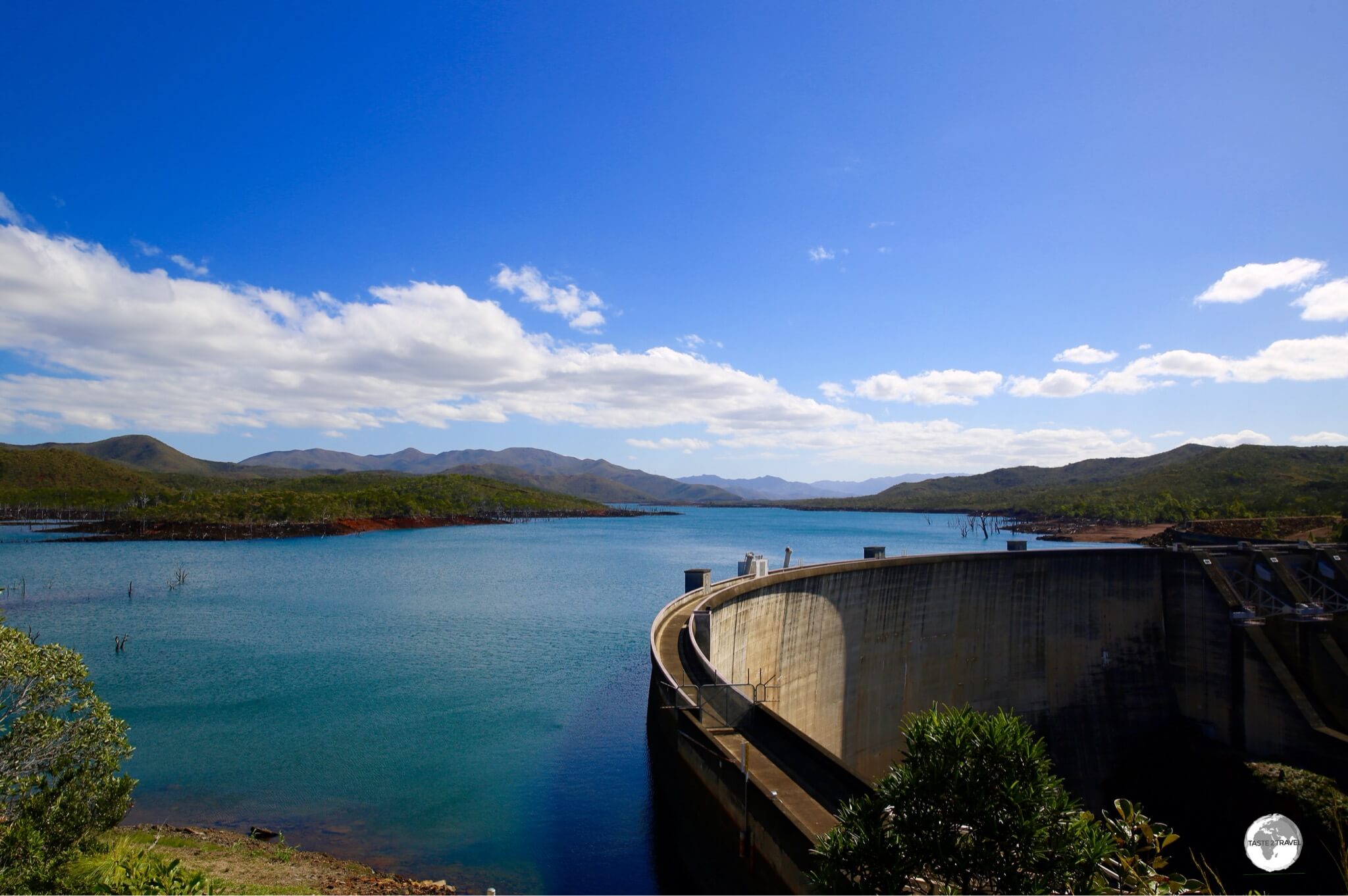
The impressive Yaté Dam was constructed in 1959 to provide power to the SLN Nickel plant in Ducos (Nouméa).
The impressive Yaté Dam was constructed to provide a reliable power source for the Nickel processing plant which is on the harbour in Noumea. The dam is 45 metres high and 641 metres long and is responsible for Lake Yaté, which is approximately 40 Km2.

A view of the east coast from the mountains above Yate village.
The sleepy settlement of Yate lies on the remote east coast of La Grande Terre. There is very little in town with the best accommodation options being in distant Noumea. If you’re driving, this is the only place with a service station in the Grand South region.

The floating jetty at the 4-star Kanua Tera Ecolodge, which lies at the end of a very lonely road at Port Boise.
At the end of a rough, red-earth, gravel road is the very remote Port de Boise. The only thing here is the deluxe Kanua Tera Ecolodge, which offers the only accommodation and restaurant option in this part of the country. They have a sister property on the Isle of Pines – see that section for more details.

View of the south coast of La Grand Terre from Cap N’Dua.
Further along the south coast, an even rougher red-earth track leads out to the lonely lighthouse at Cap N’Dua, which is part of the Cap N’Dua Reserve. From here you have spectacular views over the south coast of la Grande Terre, including the treacherous Havannah Pass.

The arid, dry, red-earth landscapes of Le Grand Sud region are reminiscent of outback Australia.
West Coast
Fort Téremba
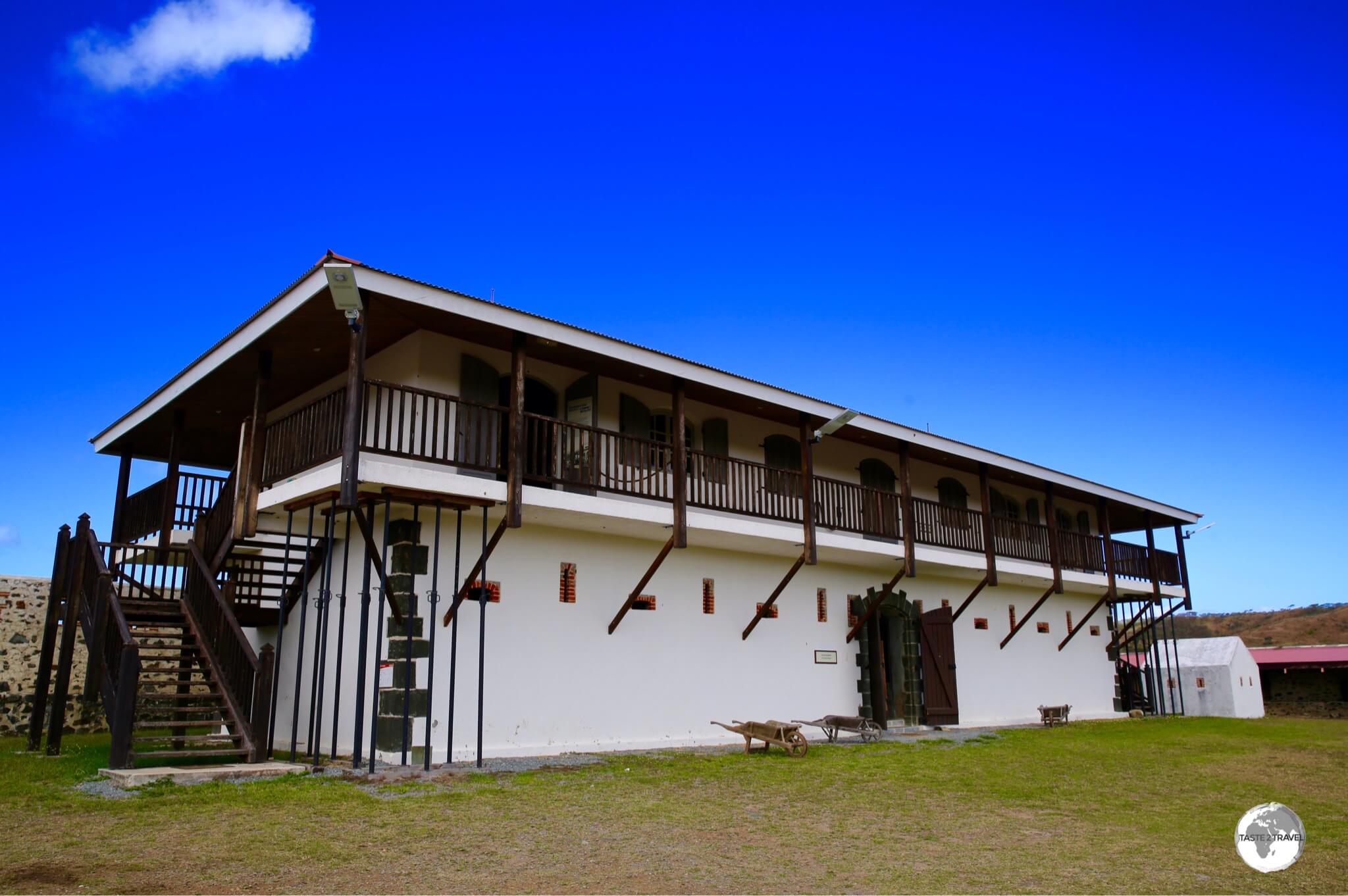
The administrative building at Fort Téremba which now houses a museum.
Located near the town of Moindou, twenty minutes north of La Foa, Fort Téremba was built to house convicts sent from France and its colonies. The construction of a military fort and a prison, overlooking Uarai bay, began in 1871 at the request of the Governor who received a contingent of twenty-five convicts, with two supervisors and three policemen. The fort was built by the convict labour.

Panoramic views of Uarai bay from the top of the watchtower at Fort Téremba.
The camp was renamed Fort Téremba by reference to the island Téremba which is in the middle of the bay. The fort overlooks Uarai bay, opposite the mouth of the La Foa River, 124 kilometres north of Noumea.

The once dilapidated watchtower at Fort Téremba has been renovated and now includes a spiral staircase.
During the Kanak revolt in 1878, the gendarmes inside the fort were killed. However, the fort was never taken and at the time it was still in very good condition. After the revolt, the military fort was redesigned and strengthened to serve as bunkers and possible refuge.

Convict graffiti decorates the wall of a cell at Fort Téremba.
By 1906, the fort had fallen into neglect and remained that way until 1984 at which point it was restored. As part of the restoration, the former administration building was converted into a museum and interpretation Centre.

The cellblock at Fort Téremba was formerly used to house convicts.
Apart from the museum, you can also visit the adjacent cellblock where original convict graffiti can be seen and climb the watchtower which offers panoramic views over the bay.

La Passerelle Marguerite in La Foa was designed and built in Paris by students of Gustav Eiffel.
Located on the main highway, immediately south of La Foa, La Passerelle Marguerite (Margaret bridge) is a suspension bridge which was shipped out in pieces from France after being designed by students of Gustav Eiffel (of Eiffel Tower fame) in 1909. It was re-assembled on-site using convict labour.
Bourail

Located on the highway, south of town, the Bourail museum and visitors centre includes informative displays which explain the history of this agricultural region.
Bourail Museum (Le Musée de Bourail) is located on the main road south of town and is housed in a former “food store”. The museum focuses on the settlement of the region around Bourail, which today is the agricultural heartland of New Caledonia.
The tourist office also shares this building and can provide maps and useful information if you are heading further north.
New Zealand War Cemetery

Located south of Bourail, the New Zealand WWII cemetery is the final resting place for 200 Kiwi soldiers killed in the Pacific war.
Nine kilometres south of Bourail on RT1 is the very well tended New Zealand War Cemetery. The cemetery serves as the final resting place for 200 NZ soldiers who were killed in New Caledonia during WWII.

A view of the New Zealand WWII cemetery near Bourail.
Baie des Tortuges

The beautiful Baie des Tortues (Turtle Bay) is a popular nesting site for sea turtles.
Located on the coast near Bourail, Baie des Tortues (Turtle Bay) is a beautiful sandy beach which is popular with swimmers and nesting sea turtles.

Baie des Tortues is lined with wildly contorted Araucaria pine trees which are endemic to New Caledonia.
While Baie des Tortues offers a fine beach, its just as famous for its impressive stand of the very rare Araucaria luxurians, which are endemic to New Caledonia.
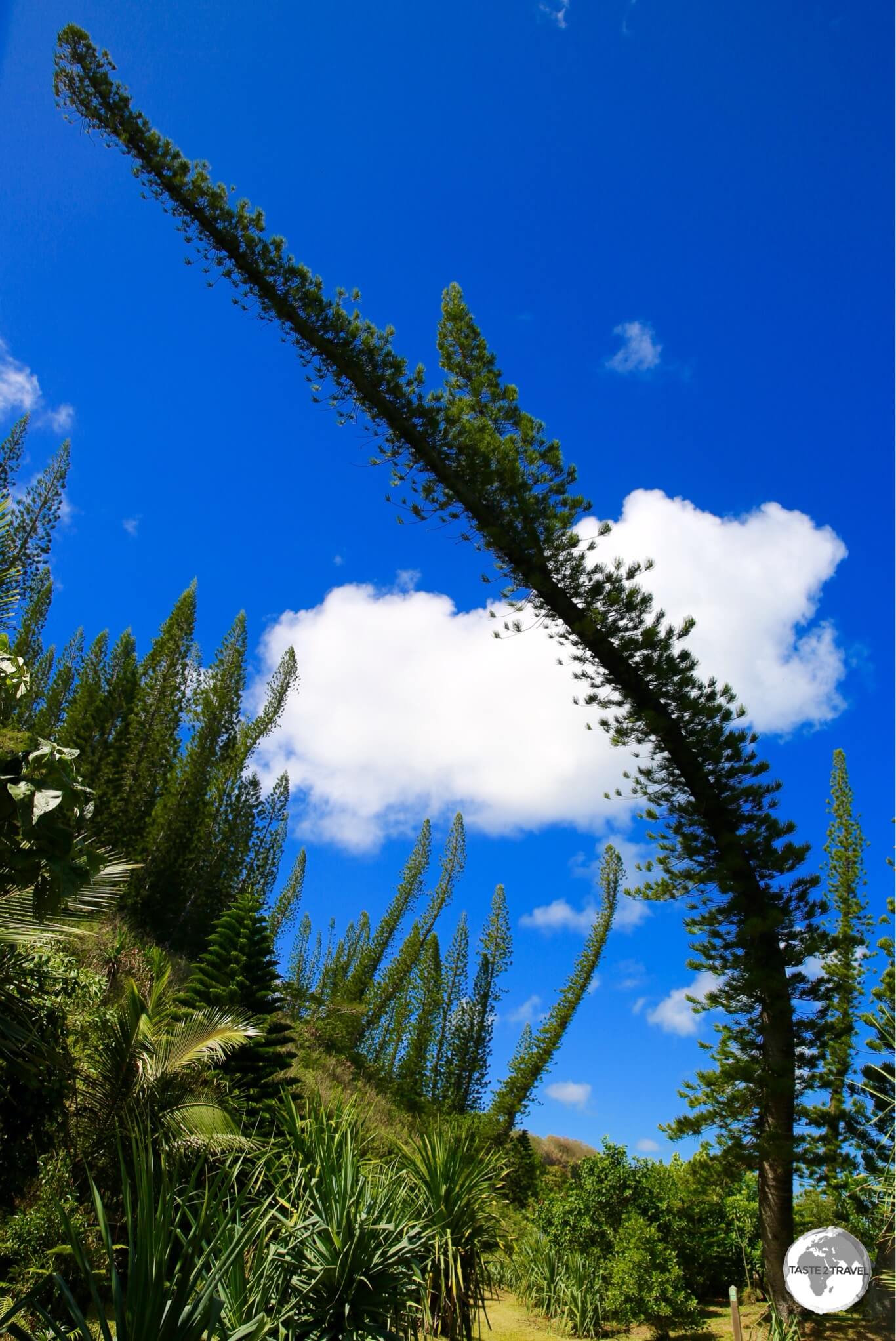
A seriously warped Araucaria pine tree at Baie des Tortues.
Araucaria luxurians is a species of conifer which grow to a height of 40 metres, but whose trunks are very narrow at just 70 centimetres. Due to their disproportion, the taller the tree, the greater the lean.

A view over Baie des Tortues.
Located a short hike along the coast from Baie des Tortuges, Bonhomme is a striking monolith rock formation sculpted by waves. ‘Bonhomme’ means gentleman in French and gets its name from its shape which is said to resemble the profile of a man wearing a hat (when viewed from the sea).

Adjacent to Baie des Tortues, ‘Bonhomme’ is a large eroded rock which looks like a gentleman wearing a hat (when viewed from sea).
Poe Beach

A view of the lagoon from Poe beach.
Located a short drive from Bourail, Poe Beach is located at the end of the long and windy Route de Poe. This protected, 13-km long, white-sand beach is very popular with families and features a campground and the luxurious Sheraton New Caledonia Deva Spa & Golf Resort.
Koné

A view of the ‘Heart of Voh’ from my microlight flight.
The Heart of Voh is a natural, heart-shaped, bog in the middle of a mangrove swamp, which was made famous by French photographer Yann Arthus-Bertrand who featured it on the front cover of his best-selling photography book – Earth from Above.

My microlight plane at Koné airport.
The best way to view the heart is from the sky. Most flights are operated by the Hotel Hibiscus in Koné who operate their own fleet of microlight planes, which are strictly reserved for guests and must be booked in advance.

With the wonderful and very capable Captain Rudy, flying over Voh.
If you are not a guest at Hotel Hibiscus, there are other options. I flew independently with the excellent Captain Rudy from Nord Ulm who was able to accommodate me at the last-minute with a 30 minute flight costing 11,000 CFP (USD$109). Not cheap, but an unforgettable experience!
Contact details for Captain Rudy:
- Email: rudyd@lagoon.nc
- Telephone: +687 84 89 77
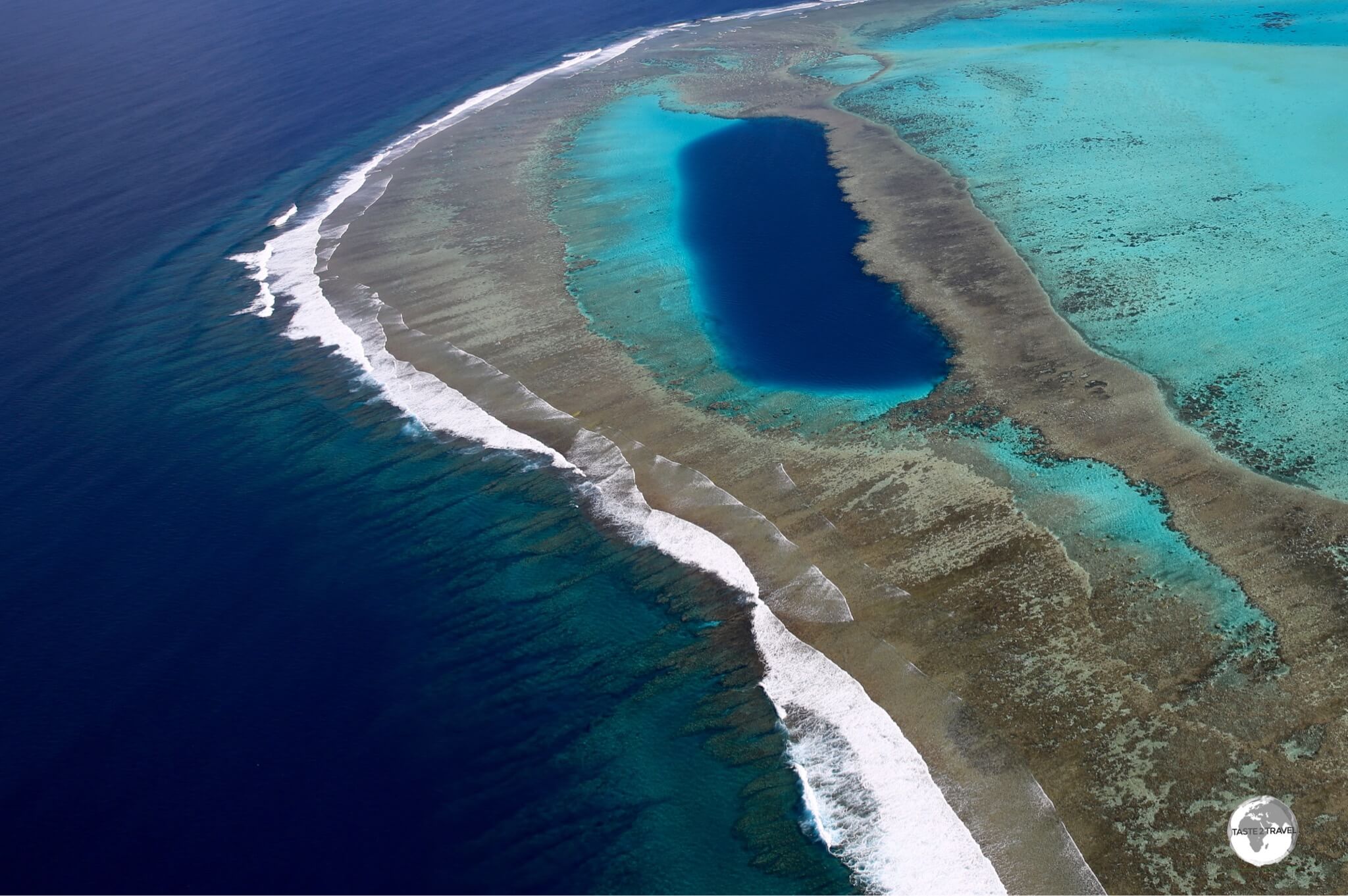
Approaching the Blue Hole, which is protected by its own fringing reef.
While on the flight, we flew over the spectacular Blue Hole – a natural hole in the middle of the lagoon (apparently 200 m deep) which is surrounded by a fringing reef that acts as a natural protection barrier. The only way to appreciate this wonder is from the air.
Koumac

The Koumac caves are hidden away at the end of a forested pathway, a few kilometres east of Koumac.
The highlight of Koumac is the Koumac Caves, which are two limestone caves located at the end of the road on the eastern (inland) outskirts of town.
The main cave is around 2.2 miles (3.7km) long, although only the first 350m metres are accessible. Bring a flashlight (or ‘torch’ app on your phone) and sturdy shoes as you need to climb boulders to access the main cave.

The Seabreeze catamaran provides a regular connection between Koumac and the Belep archipelago.
If you wish to travel to the remote northern Belep Islands, you can take the daily Seabreeze catamaran from Koumac Marina.
The catamaran completes the 110-km journey in 4 hours, departing Koumac at 14:00 and arriving in Belep at 18:00. On the return journey, the catamaran departs Belep at 06:00, arriving in Koumac at 10:00. A one-way ticket costs 3,510 CFP (USD$35).
Contact details:
- Telephone: +687 42 57 74 or 47 57 18
- Email: reservations@yalapbelep.nc
The Far North

The far north of La Grande Terre is characterised by arid, hilly countryside, which reminded me of Australia.
The drive to the far northern tip of La Grand Terre takes you on an isolated road, through beautiful, hilly countryside to the small settlement of Poum after which the road becomes a dusty, gravel track to the most northern point on the mainland – Boat Pass.

Boat Pass is the most northern point on La Grande Terre.
It’s all very lonely at the top of the mainland but the beach-side Relais de Poingam offers a choice of accommodation (including camping) plus a restaurant.

In my rental car on the road to the far northern settlement of Poum.
The most luxurious accommodation at the top-end of the island can be found south of Poum. The beachside Hotel Malabou is part of the ‘Grands hotel‘ group and offers the usual level of high service and impeccable facilities for which this group is renown.
East Coast

A view of the rugged East Coast of La Grand Terre, north of Hienghène.
The drive from the west coast to the east coast between Koumac and Hienghène takes you high into the central mountain range from where you have spectacular views of the east coast before the road descends into the coastal village of Pouebo.
Cascade de Tao

Cascading 100 metres, ‘Cascade de Tao’ is the highest waterfall in New Caledonia.
With a drop of 100 metres, Cascade de Tao is the highest waterfall in New Caledonia as well as the most impressive, plunging in two dramatic leaps with several sloping tiers.
Hienghène

Hienghène is famous for its various funky limestone-rock formations.
Located in northeast New Caledonia, Hienghène is most famous for its incredible geological formations. These limestone rocks, with names such as ‘Sphinx’ and ‘La Poule de Hienghene’ (‘The Hen Of Hienghene’) are easily viewed from the highway.

A roadside cemetery on La Grand Terre.
The town itself is a very small, quiet village which offers very limited services (no supermarket, one gas station located miles from anywhere and one restaurant with limited opening hours).
If you are interested in Scuba Diving, their are several reefs offshore which provide interesting diving.
Isle of Pines
Vao

The Isle of Pines was named by Captain James Cook who was intrigued by the unique, towering Araucaria pine trees, which can be found all over the island.
The main settlement on the Isle of Pines, Vao is a sleepy village which is home to one school, one grocery store, a church, a government administration building and not much else!
Kuto Bay

A true paradise! Kuto Bay on the Isle of Pines.
One of the most stunning bays you’ll ever see, and home to a decent accommodation option and one of the few restaurants on the island – Hotel Kou Bugny (see the ‘Accommodation‘ section below for more details), Kuto bay is the best place to base yourself while on the Isle of Pines.
Kanumera Bay

The beautiful Kanumera Bay lies a short walk from Kuto bay.
Located around the corner from Kuto bay, the equally stunning Kanumera Bay is the perfect place to swim and snorkel. There are several accommodation options at the southern end of the bay.
Ouro

An abandoned penal cell block in the village of Ouro on the west coast of the Isle of Pines.
Penal Buildings – north of Kuto Bay, in the village of Ouro are the abandoned remains of various penal buildings, including cell blocks. The whole complex is very overgrown and deserted and at one point it did seem like I was on the set of an Indiana Jones movie. A very cool place to explore!
Baie de Gadji
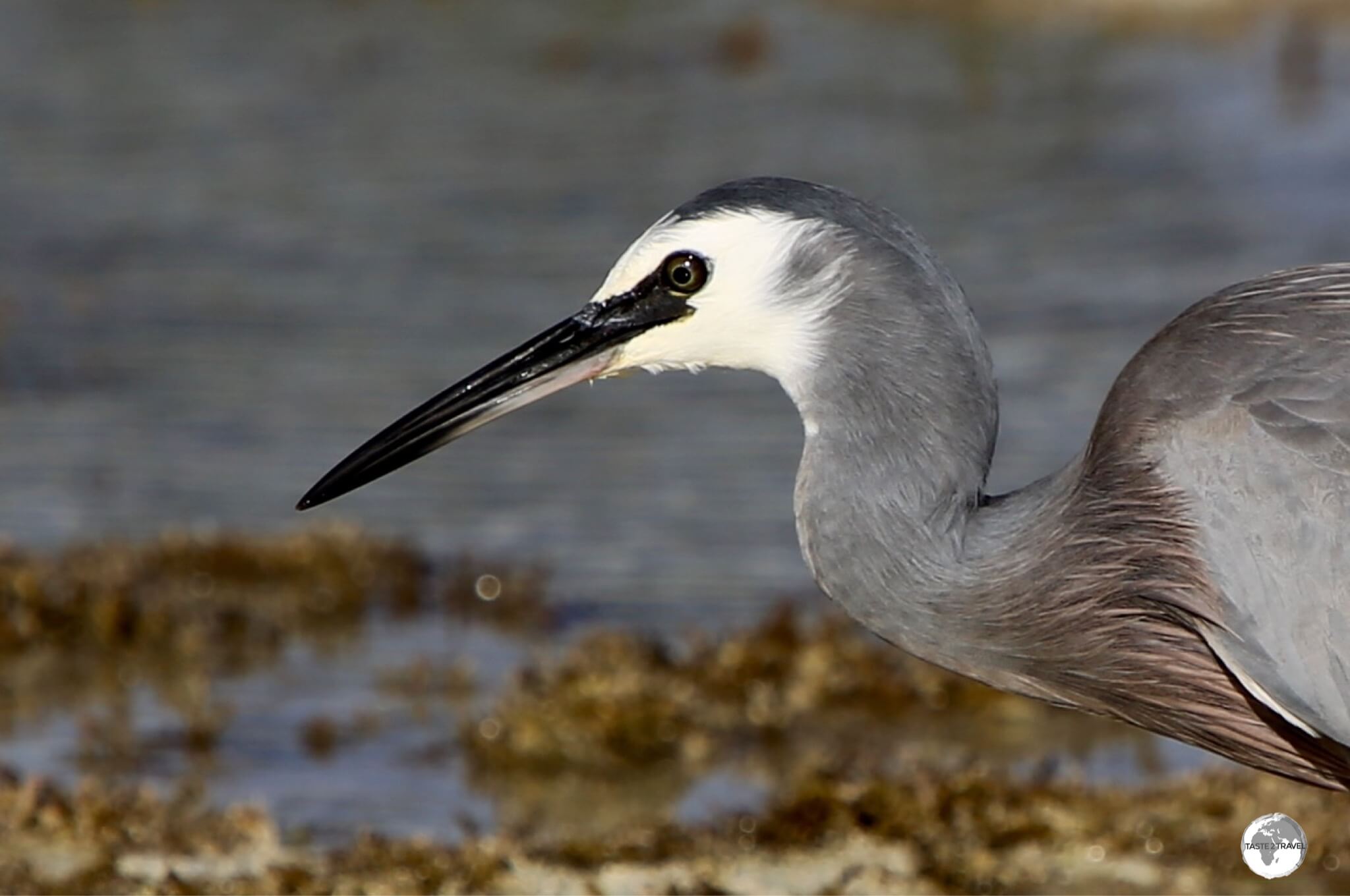
A White-faced Heron, fishing for a meal, at Baie de Gadji.
Located on the northwest side of the Isle of Pines, Baie de Gadji is a protected bay which is a favoured anchorage for visiting yachts. With its bleached white beaches, uninhabited islands, turquoise blue water and world-class snorkelling, weary sailors tend to get stuck here.
Grotte de la Reine Hortense

The entrance to the impressive Grotte de la Reine Hortense on Isle of Pines.
Grotte de la Reine Hortense – Located near the airport, the impressive Grotte de la Reine Hortense is reached by a short pathway which meanders through a lush rainforest.

A lush forest surrounds the Grotte de la Reine Hortense.
The cave is named after Queen Hortense, the wife of a local chief, who is believed to have taken refuge here for several months during intertribal conflict in 1855.
Oro Bay

Situated on Oro bay, Le Meridien hotel offers the only 5-star accommodation on the Isle of Pines.
Set on the beautiful and remote, turquoise-coloured, crescent-shaped Oro Bay, Le Méridien Ile des Pins is the only 5-star resort on the island. If you’re booking your honeymoon accommodation or looking for a dream escape, this is the place for you!
Piscine Naturelle

Araucaria pine trees provide the perfect backdrop for the Piscine Naturelle on the Isle of Pines.
A highlight of the Isle of Pines is the pristine, Piscine Naturelle (Natural Pool), which is located a short drive from Le Méridien.
This natural pool occupies a stunning setting which includes a backdrop of soaring Araucaria pine trees. The pool is cut-off from the nearby ocean so is very protected and includes a dazzling array of marine life – even a Lionfish or two!
There are no shops here, so you’ll need to bring your own snorkel equipment and anything else you may need.

A roadside Kanak cemetery on the Isle of Pines.
Accommodation

My room at the not-so-central “Hôtel du Centre” in Noumea.
Noumea
There’s no shortage of accommodation in Nouméa, with options to suit all budgets. Downtown is not too charming and offers few hotels, while the main tourist hubs are the two beachside neighbourhoods of Baie des Citrons and Anse Vata – a short drive south of downtown.
Hôtel du Centre – The name of this hotel is a bit of a misnomer as it’s located nowhere near the centre of anything! A modern, funky, well-designed hotel, this property would be perfect if it was located anywhere else in town, however its setting in a semi-industrial zone on the northern outskirts of town makes this option totally unappealing.
Hotel Beaurivage – Part of the national Grands Hotel group, Beaurivage is perfectly located on the beach in Baie des Citrons and always priced to sell. Overlooking the beach, this well-designed hotel features spacious rooms, plenty of parking and is a short walk from the many restaurants and bars of Baie des Citrons. A perfect option!
La Foa

Interior of my shipping container room in La Foa.
Like many towns outside of Nouméa, La Foa has limited accommodation options, with most places being private homes listed on Airbnb.
While in town, I stayed with the amazing Christophe (French expat) and Jenny (his Indonesian wife), a wonderful couple who have set up a guest room in a converted shipping container in the garden of their property on the outskirts of town.
The container has been furnished with wooden furniture imported from Indonesia and Jenny occasionally cooks Indonesian dinners for her guests. You can book their container through Airbnb.

Interior of my shipping container room in La Foa, complete with Indonesian furniture.
The only hotel option in La Foa is the colonial-era relic that is Hotel Banu. Located on the main road, it seems the hotel was last renovated during the colonial period and as such gets mixed reviews. It’s home to the only bar in town, which is very lively and features a ceiling plastered in baseball caps. It’s also home to one of two restaurants in town so all visitors end up here at some stage.
Koné

My beautiful and spacious room at La Nea hotel in Koné.
Popular Koné features a few fine hotel options, with the downtown Hotel Hibiscus being the pick of the bunch. If you plan on flying in an ultra-light over the ‘Heart of Voh‘ you should know that the Hotel Hibiscus have their own planes which are made available only to their guests. If you are staying elsewhere you’ll have to organise your flight through your hotel.
The national ‘Grands Hotel‘ group has two properties located a short drive north of town, the Hotel La Nea and the Koniambo, which is opposite the airport.
I stayed at Hotel La Nea, which consists of a barricaded, private street which is lined with thirty private, spacious bungalows. Apparently, the bungalows were originally built to house construction workers who worked on the massive Koniambo mine in nearby Voh.
Koumac

The bedroom of my shipping container guest house near Koumac.
Like most towns in New Caledonia, accommodation options in Koumac are very limited. I booked another shipping container guest house through Airbnb, which was located 10-km south of town on the main highway.

With the addition of a 2nd container, Claudia and Pascal have created a spacious shipping container experience which includes a kitchen and living area.
Located on a large country lot, which is owned by Claudia & Pascal, another French ex-pat couple, this shipping container experience has been improved considerably by joining two containers in an ‘L’ shape.

The exterior of my shipping container guest house at Koumac.
The addition of the 2nd container allows plenty of space for a bedroom, bathroom, kitchen and living area. The containers are surrounded by a private garden area with seating. It’s all very inviting and relaxing with the main family house located away from the container.
You can book the container through Airbnb.
Hienghène

Sunset from Le Koulnoué Village in Hienghène.
Despite being a popular tourist destination, the sleepy east coast settlement of Hienghène has few accommodation options. The national Grands Hotel chain once again saves the day by offering the wonderful Le Koulnoué Village which is located on a sandy beach south of town.
The resort is popular with visiting French families who book all-inclusive packages. The meals served in the restaurant are amazing, with French chiefs elevating buffet dining into an art form rarely seen. Like all other restaurants in New Caledonia, the doors are firmly closed in between meals so don’t arrive mid-afternoon looking for a snack.
Isle of Pines
Accommodation options on the Isle of Pines are limited and the island is popular so best to book well in advance.

Even on a stormy day, Kuto Bay is still magnificent.
I stayed at the wonderful Hotel Kou Bugny which is located across the road from the stunning Kuto Bay. The hotel has its own fleet of rental cars which is ideal as one is needed in order to fully explore this charming island (see ‘Rental Cars’ below for more details).
Located around the corner from Kou-Bugny, on picturesque Kanumera bay, is the very comfortable Oure Tera resort, which is owned by the same competent folks who run the deluxe Kanua Tera Ecolodge at Port de Boise. The resort serves the best coffee on the island.
Eating Out

The popular ‘Number One’ beer really is #1 in New Caledonia.
Noumea
The capital of this French territory is home to many fine dining options with French chiefs regularly trading in the cold, European weather for a spell of balmy, tropical warmth. Europe’s loss is the Pacific’s gain.
Restaurants are concentrated in the southern beach side neighbourhoods of Baie des Citrons and Anse Vata where you’ll find a variety of establishments serving cuisine from around the world.
My regular breakfast café each morning was the wonderfully funky French café which is located around the corner from the Aquarium, on the beach at Anse Vata. The café is managed by the friendly and energetic duo or Max and Julien. Max recently finished a two-year contract, working in the mines of Western Australia and loves welcoming Aussies into the café and also loves practising his new-found Australian accent. G’day mate!
La Foa

Baseball caps line the ceiling of the bar at the Hotel Banu in La Foa.
There are two dining options on the main street in La Foa, the historic (1883) Hôtel Banu, which is an institution in these parts and is famous for its forest of baseball caps which are pinned to the ceiling of the main bar. Food and service here are very good.
Diagonally opposite Hôtel Banu is Le Jasmin, which serves Asian fusion and French crêpe’s . The old adage, ‘When in Rome‘, applies here and while the Asian menu items are terrible, the Crêpes are very good.
Koné
For fine dining in Koné, there is but one option, the wonderful restaurant at Hotel Hibiscus whose menu features local ingredients including beef from Bourail.
Located on the southern outskirts of Koné, inside the modern Teari shopping mall, the Au Palais Gourmand is possibly the best patisserie and boulangerie outside of Noumea. Open from early morning to early evening, 7 days a week, this slice of heaven offers crusty, artisanal baguettes, the freshest, buttery croissants, pain au chocolat and an amazing selection of sandwiches and pastries.
Koumac
The best (and only) restaurant option in Koumac is the excellent, waterfront Le Skipper. Like most restaurants in New Caledonia, this one closes after lunch (I arrived at 1:30 pm and was too late) and reopens at 7:00 pm for dinner.
If you get stuck, there’s a small snackette on the main street near the Post Office which serves hamburgers etc. This roadside, converted shipping container, closes promptly at 2 pm and while I was there, some unlucky (hungry) tourists were turned away since they had arrived just after closing time.
Hienghène
I consumed all my meals at Le Koulnoué Village which offered buffet breakfast and dinner (no need for lunch in between the gluttonous buffets).
The only restaurant option in the village is at the hilltop Ka Waboana Lodge, which – like most establishments in New Caledonia – closes between meals – check their website for current operating hours.
Isle of Pines
Dining options on the Isle of Pines are very limited. Overlooking the stunningly beautiful Kuto Bay, the Hotel Kou-Bugny restaurant and terrace bar welcomes clients whether they’re staying in the hotel or not – since there are few other places to eat on the island. The restaurant serves buffet-style meals and is closed outside of mealtimes. The adjacent terrace bar serves snacks throughout the day.
The restaurant at Oure Tera resort serves meals to clients and outside guests while the restaurant at Le Méridien Ile des Pins is the only dining option on the east coast. Prices are not too scary but the food is hit and miss.
Visa Requirements

New Caledonia passport stamps.
While New Caledonia is an overseas collectivity of France, it is not part of the Schengen Area and as such applies its own visa policy (which largely mirrors the Schengen Area policy). Generally, EU citizens are free to enter and reside indefinitely while many other passport holders are granted a 3-month stay. To check your requirements, click here.
Immigration
Immigration in the French territories is the breeziest of anywhere in the Pacific. No questions asked, no need to show a return ticket, nothing! Most visitors are processed in a matter of seconds – the way travel should be!
Getting There

Located on the north coast, 50-km north of Noumea, the very quiet La Tontouta airport is the international gateway to New Caledonia.
Air
International flights at La Tontouta International Airport (IATA: NOU) which is located in the middle of the countryside 52-km northwest of Noumea.
The following airlines provide services:
- Air New Zealand – flies to/ from Auckland
- Air Vanuatu – flies to/ from Luganville, Port Vila
- Aircalin – flies to/ from Auckland, Brisbane, Melbourne, Nadi, Osaka-Kansai, Papeete, Port Vila, Sydney, Tokyo-Narita, Wallis Island
- Qantas – flies to/ from Brisbane, Sydney
Airport Transport
Taxis rarely make it out to the airport as most people in the know avoid the unnecessary expense and take the airport shuttle service which is operated by Arc en Ciel, which is located outside the terminal doors, next to the rental car counters. A one way fare to Noumea is 3,000 CFP.
Sea
Cruise ships dock at the container terminal in Noumea and occasionally visit the Isle of Pines, where they dock in the very beautiful Kuto Bay.
Getting Around

My Air Caledonie flight from Noumea to the Isle of Pines.
Air
Domestic flights operate out of the much more conveniently located Nouméa Magenta Airport which is 3 km from downtown Noumea.
The airport serves as a base for the main domestic carrier – Air Calédonie – and the smaller Air Loyauté, which provides connections to the Loyalty islands.

The view from my flight to the Isle of Pines.
A word on baggage limits: Air Calédonie, provide you with the option to purchase a ticket allowing you to check in either 12 kg or 20 kg of baggage. You are only allowed one (1) carry-on item which must not exceed 5 kg.
They do weigh your carry-on and will charge excess fees if you’re overweight. The normal rule of one carry-on and one personal item does not apply for domestic flights in New Caledonia. I travel with a camera bag and laptop bag and was charged 3,500 CFP (US$34) at Magenta airport for excess ‘carry-on’ baggage.

An Air Caledonie flight, ready to depart Koné airport.
The following airlines provide services from Nouméa Magenta airport:
- Air Calédonie – files to/ from Île-des-Pins, Koné, Koumac, Lifou, Maré, Ouvéa, Tiga, Touhoac
- Air Loyauté – flies to/ from Lifou, Maré, Ouvéa, Tiga

Isle of Pines Airport.
Public Bus
There are three different bus companies offering connections around Noumea and throughout La Grand Terre:
- Within Noumea: The very efficient, red-and-white, Karuia Buses operate throughout the capital, providing connections to most parts of the city. You can view their current route map here and timetables here.
- Greater Noumea region: Carsud operates 13 routes which connects the capital with the ever-sprawling greater Noumea region. Destinations served include Tontouta Airport, Dumbéa, Païta, Normandie, Boulari, Plum and Mont-Dore. A route map can be viewed here while detailed route plans and timetables can be viewed here.
- Interurban Coach: The RAI bus company provides connections between the capital and 360 different destinations on La Grand Terre. You can check the current schedule and tariffs here, while route maps can be viewed here.
Taxi

Taxis are not always easy to find in Noumea, especially after-hours.
There are currently 65 taxis operating in Noumea and most of these are unavailable outside of business hours.
Taxi drivers in Noumea do not work hours to suit their customers’ needs but instead work to suit their own needs. If you need to take a taxi in the evening or anytime on a weekend, you should order one well in advance (I once waited 40 minutes for a taxi to arrive on a Saturday morning).
There are three different tariffs charged – A, B and C according to the time and day with a fare around town averaging 1,000 CFP (USD$10).
Taxis can be booked by calling +687 28 35 12. Full details on tariffs can be viewed here.
Rental Car

My rental car, crossing a river in a remote corner of Le Grand Sud region.
La Grand Terre
All the usual rental car companies are represented at Tontouta airport and in downtown Noumea.
A rental car is the best way to explore the many remote corners of La Grand Terre. The French government spends a healthy amount on infrastructure, making a road-trip on New Caledonia a pleasant experience.
Car rental offices often close for two hour lunch breaks so best to confirm their opening hours before you visit.
Isle of Pines

With a complete lack of public transport, a rental car is the best way to explore the Isle of Pines.
With a complete lack of public transport, if you wish to explore the Isle of Pines you’ll need to rent a car or take a guided tour.
The Hotel Kou Bugny has a small fleet of compact rentals with rates of around 6,500 CFP (USD$64) a day (not a 24-hour rental period) so if you take the car at lunchtime, you will be required to return it that evening at the same daily rate.

A New Caledonia license plate.
Ferry
Ferry Betico offers regular connections between their Gare Maritime in downtown Noumea and the Isle of Pines and the Loyalty islands of Mare and Lifou. Current schedules and tariffs are available on their website.
Unlike other Pacific nations, ‘rubber time’ does not exist in well-organised New Caledonia. The Betico is very punctual, so if your departure is for 7 am and you arrive at 7:05 am, you’ll get to wave as the boat sails away – without you on board.
That’s the end of my New Caledonia Travel Guide.
Safe Travels!
Darren
Follow me on Instagram:
[instagram-feed feed=1]
Further Reading
- Other travel reports from the Pacific region:
New Caledonia Travel Guide New Caledonia Travel Guide New Caledonia Travel Guide New Caledonia Travel Guide New Caledonia Travel Guide New Caledonia Travel Guide New Caledonia Travel Guide New Caledonia Travel Guide New Caledonia Travel Guide New Caledonia Travel Guide New Caledonia Travel Guide New Caledonia Travel Guide New Caledonia Travel Guide New Caledonia Travel Guide New Caledonia Travel Guide New Caledonia Travel Guide New Caledonia Travel Guide New Caledonia Travel Guide New Caledonia Travel Guide New Caledonia Travel Guide New Caledonia Travel Guide New Caledonia Travel Guide New Caledonia Travel Guide New Caledonia Travel Guide New Caledonia Travel Guide
Author: Darren McLean
Darren McLean is an Australian, full-time, digital nomad who has spent 37 years on a slow meander around the globe, visiting all seven continents, 192/ 193 UN countries and 245/ 251 UN+ countries and territories.
He founded taste2travel to pique one’s curiosity and inspire wanderlust.


